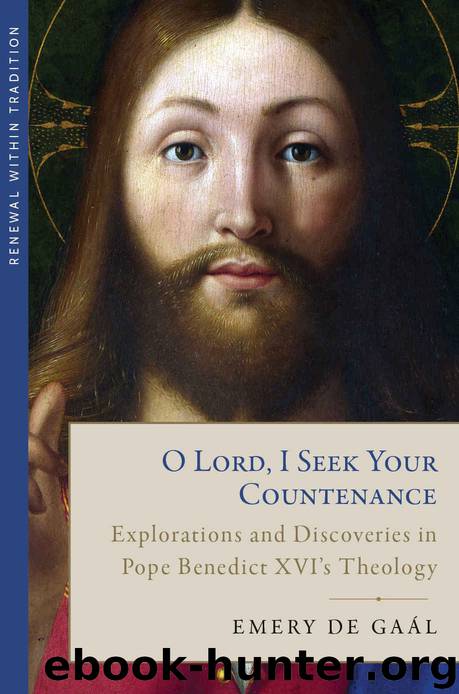O Lord, I Seek Your Countenance: Explorations and Discoveries in Pope Benedict XVI's Theology (Renewal within Tradition) by Emery de Gaal

Author:Emery de Gaal [Emery de Gaal]
Language: eng
Format: epub
Publisher: Emmaus Academic
Published: 2018-09-30T16:00:00+00:00
FINAL ASSESSMENT
The summary of a one-semester lecture written in staccato style is nolens volens more an outline of headwords. This notwithstanding, the core points of Ratzinger’s Mariology can be distilled from this course. They recur later in his writings, impact his drafting of chapter 8 of Lumen gentium (52–69), and characterize his statements as Supreme Pontiff.
The first chapter of the course follows the well-known outlines established by Matthias Premm, Ludwig Ott, and Michael Schmaus. The Ephesinum—namely, Mary as Mother of God—is apprehended as primarily a Christological statement.90 However, while these theologians emphasize the conventional perspective of Mary’s privileges,91 Ratzinger begs to differ. His new Mariologisches Grundprinzip argues from Mary’s faith. Mary is the first believer and the origin of the ecclesial reality. This explains the contrast between Christ and the Church/Mary in the scriptum, a distinguishing feature of this text. This personalist perspective is subsequently further developed in Daughter Zion and Mary: Church at its Origin.92 Mary is the personification and concretion of the Church, of the ecclesia as the holy earth, Daughter of Zion, and sign of eschatological perfection. The scriptum stresses that Christian existence is grounded in encounter.93 In Mary, the ideal of divine call and human hearing and response is realized (DCE 42). This Marian understanding of the Church prevents her members from falling prey to the temptation to “make” the Church. Many years later, reflecting on the Second Vatican Council, Ratzinger observes:
Church is not a contrivance or an apparatus, not merely an institution or one of the usual sociological entities—she is a person. She is a woman; she is a mother. She is alive. The Marian understanding of the Church is the most categorical antithesis to a merely organizational or bureaucratic concept of Church. We cannot make Church; we must be Church. And we are Church, and Church is in us only insofar as faith shapes our being, above and beyond anything we do. Only in Marian being do we become Church. At the origins, too, Church was not made but born. She was born when the fiat was awakened in Mary’s soul. That is the most profound desire of the Council: that the Church might awaken in our souls. Mary shows us the way.94
For this reason, he calls the incorporation of Mariology into the Dogmatic Constitution on the Church, Lumen gentium, “a spiritual watershed.”95
His Mariology is decidedly Christocentric, and the figure of Mary is essentially ecclesio-typical. For the theologian Ratzinger, all the other Marian titles emerge from the fifth-century dogmatic definition of the Theotokos, which dogmatically undergirds and enables all subsequent statements concerning Mary. Although “canonical exegesis” will only later be a topos with Ratzinger, the concept is already implicitly evident in his Mariology course in the sense of Augustine’s dictum: “Novum in Vetere latet, Vetus in Novo patet.” Pope Benedict XVI has always read Scripture with the canonical nature of the text in mind. It has only more recently become known as the “canonical” approach, thus coined by the American theologian Brevard Childs. It is an essential dimension of his interpretation of Scripture.
Download
This site does not store any files on its server. We only index and link to content provided by other sites. Please contact the content providers to delete copyright contents if any and email us, we'll remove relevant links or contents immediately.
Resisting Happiness by Matthew Kelly(3197)
The Social Psychology of Inequality by Unknown(2770)
Designing Your Life by Bill Burnett(2603)
Day by Elie Wiesel(2596)
The Giving Tree by Shel Silverstein(2174)
Angels of God: The Bible, the Church and the Heavenly Hosts by Mike Aquilina(1870)
Human Design by Chetan Parkyn(1859)
The Supreme Gift by Paulo Coelho(1799)
Jesus of Nazareth by Joseph Ratzinger(1709)
Augustine: Conversions to Confessions by Robin Lane Fox(1688)
Hostage to the Devil by Malachi Martin(1676)
7 Secrets of Divine Mercy by Vinny Flynn(1620)
Dark Mysteries of the Vatican by H. Paul Jeffers(1607)
The Vatican Pimpernel by Brian Fleming(1587)
St. Thomas Aquinas by G. K. Chesterton(1557)
Saints & Angels by Doreen Virtue(1530)
The Ratline by Philippe Sands(1425)
My Daily Catholic Bible, NABRE by Thigpen Edited by Dr. Paul(1418)
Called to Life by Jacques Philippe(1410)
